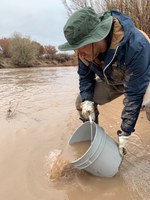ABQ BioPark Releases 15,000 Rio Grande Silvery Minnows into the River
BioPark's Aquatic Conservation Facility continues 19-year partnership to help conserve the endangered fish.
Nov. 22, 2019 - The ABQ BioPark continued its mission to help conserve the New Mexico native Rio Grande silvery minnow by releasing 15,000 tagged fish into the Rio Grande on November 21.
This follows a release of 18,000 fish in February, and more than 800,000 since 2000 in cooperation with the Middle Rio Grande Endangered Species Collaborative Program.
The Rio Grande silvery minnow, a 2- to 4-inch long fish, was once one of the most common species in the Rio Grande, but by 1994 its population had declined so greatly that it was added to the federal Endangered Species List.
According to Kathy Lang, curator of the ABQ BioPark's Aquatic Conservation Facility, 2018 was a difficult year for wild Rio Grande silvery minnows and biologists were worried that there weren't enough fish left in the river to produce the next generation. High river flows in 2019 led to large numbers of silvery minnows being spawned, so captive-bred fish were not required to augment the wild population. However, this year's release of tagged fish is still important to continue investigations into silvery minnow maturation and survival.
"Participating in research into the life history of the Rio Grande silvery minnow is a critical part of the BioPark's involvement in the conservation of the species," said Lang. "We look forward to working with the collaborative program for years to come."
"It may be a small fish, but the well-being of the silvery minnow is an indicator of something much larger: the health of the Rio Grande," Mayor Tim Keller noted. "The BioPark's conservation efforts continue to make a difference in the survival of this species."
The BioPark has been part of the recovery program for the Rio Grande silvery minnow since 2000. Each spring, staff from the BioPark's Aquatic Conservation Facility collect eggs from the Rio Grande to hatch in tanks at the BioPark, and also breed additional minnows from previously collected broodstock. Fish destined for release are "tagged" with a small colored mark before their release so biologists can monitor the success of the program. Tagging also allows biologists to monitor some aspects of the minnows' behavior and how long the fish are surviving in different parts of the river.
Releasing fish with slightly different tags in November and February may indicate which release time gives the Rio Grande silvery minnows the best chance of surviving.

